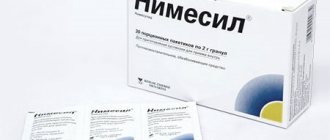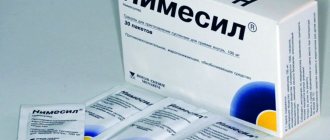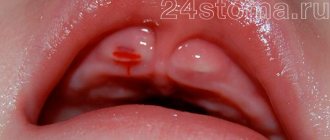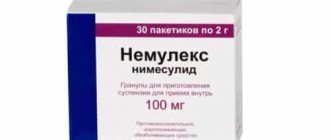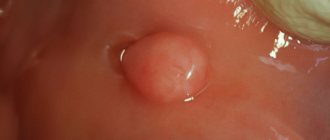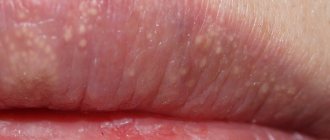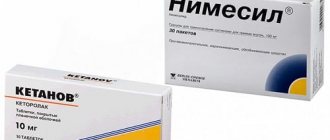Nimesil for toothache is considered one of the most effective remedies that can eliminate this unpleasant symptom. The medicine has anti-inflammatory properties and is classified as a non-steroidal drug. Nimesil for toothache has one important feature: it begins to act within 30 minutes after administration, and the effect lasts about six hours. Despite such high effectiveness, the use of the drug, according to some doctors, can lead to serious consequences.
Pharmacological properties of the drug Nimesil
Pharmacodynamics. Nimesulide (4-nitro-2-phenoxymethanosulfonanilide) is an NSAID of the methanesulfonanilide group, has anti-inflammatory, analgesic and antipyretic effects. The therapeutic effect of nimesulide is due to the fact that it affects the metabolism of arachidonic acid and reduces the biosynthesis of prostaglandins by inhibiting COX. Due to the selective effect on COX-2, the synthesis of prostaglandins with a cytoprotective effect in the gastric mucosa is not disrupted, and the risk of side effects is reduced. In addition, nimesulide reduces the formation of superoxide anions by neutrophil granulocytes and inhibits the formation of free radicals formed during inflammation. Pharmacokinetics. It is well absorbed when taken orally, reaching Cmax in blood plasma after 2–3 hours. Up to 97.5% of nimesulide is bound to blood plasma proteins. Nimesulide is actively metabolized in the liver with the participation of CYP 2C9, an isoenzyme of cytochrome P450. The main metabolite is a parahydroxy derivative, which also has pharmacological activity. T1/2 - 3.2–6 hours. Nimesulide is excreted from the body in the urine - about 50% of the dose taken. About 29% of the dose taken is excreted in the feces in a metabolized form and only 1–3% is excreted unchanged from the body. The pharmacokinetic profile does not change in elderly people. With long-term use it does not accumulate in the body.
Action of Nimesil
Nimesil for toothache, when entering the body, inhibits the formation of prostaglandins. The latter are chemical compounds, the synthesis of which occurs in almost all tissues, including blood vessels. Prostaglandins do not have a direct effect on the course of pain. However, they enhance the effect of compounds that provoke the development of the inflammatory process.
Nimesil is prescribed for toothache caused by:
- Caries
- Pulpitis
- Gum pathologies and other dental ailments
At the same time, the medicine suppresses the development of the inflammatory process. It is important to understand that Nimesil for toothache is a temporary remedy. It is not able to eliminate the disease that caused the discomfort. To eliminate the latter, other measures are necessary.
Use of the drug Nimesil
Nimesil is prescribed after a thorough assessment of the benefit/risk ratio. Use the minimum effective dose for the shortest possible time to reduce side effects. The maximum duration of treatment with Nimesil is 15 days. Adults and elderly people : 1 sachet of 100 mg 2 times a day (daily dose - 200 mg). Children over 12 years of age : no dose adjustment is required. Patients with impaired renal function : For patients with mild or moderate renal impairment (creatinine clearance 30–80 ml/min), no dose adjustment is required. The contents of the portioned sachets are poured into a glass, dissolved with water and taken orally after meals.
Methods and dosages in the instructions for use of Nimesil
The granular product is diluted in half a glass of water, the finished substance should be used immediately. The drug is taken orally, 1 sachet after meals, twice a day. Therapeutic manipulations should not exceed 2 weeks. To prevent the development of adverse reactions, the medication is prescribed in minimal effective dosages.
The instructions for use of Nimesil do not contain any special instructions for the treatment of children - in the period from 12 to 18 years, therapy is carried out at adult dosages. If the patient has a history of kidney disease, then the standard amount and frequency of use of the solution remains unchanged.
In old age, the characteristics of the body are taken into account; all changes in the therapy recommended by the manufacturer are carried out on the recommendation of a doctor. The specialist is based on the compatibility of the drug with other medications.
Doctors do not recommend using Nemisil for minor attacks of headache or without a prescription from a local physician. The drug is not suitable for continuous use and can cause serious adverse reactions, including anaphylactic shock and coma. The appearance of unusual clinical signs requires immediate contact with a local physician.
Contraindications to the use of the drug Nimesil
Hypersensitivity to nimesulide or to any component of the drug. History of hyperergic reactions (bronchospasm, rhinitis, urticaria) due to the use of acetylsalicylic acid or other NSAIDs. History of hepatotoxic reaction to nimesulide. Peptic ulcer of the stomach or duodenum in the acute phase, recurrent peptic ulcers or gastrointestinal bleeding, cerebrovascular bleeding or other conditions accompanied by bleeding. Significant bleeding disorder. Severe heart failure. Severe renal failure. Liver failure. Children under 12 years of age. In the third trimester of pregnancy and the period of breastfeeding. Fever and flu-like symptoms, suspicion of acute surgical pathology. Do not use simultaneously with other drugs that may cause hepatotoxic reactions. Alcoholism and drug addiction.
Analogues of the product
There are dozens of types of drugs on the pharmaceutical market that are structural analogues of Nimesil. The similarity of the therapeutic effect and possible side effects on the body of these drugs is due to a single active component - nimesulide. According to reviews from many people, the result of using these drugs is no different from taking Nimesil. Moreover, many analogues are much cheaper than this analgesic.
Examples of medicines that can be used as a substitute for Nimesil:
- Coxtral tablets;
- Aponil tablets;
- Nimegesic tablets and suspension;
- granulate for preparing Mesulide suspension;
- Novolid tablets;
- Nimulid tablets;
- Prolid tablets;
- Ameolin tablets.
This is a partial list of pharmaceuticals. Every pharmacy has several types of structural analogues of Nimesil. Full information about available substitutes for this analgesic can be obtained from your pharmacist.
You cannot independently choose a drug to relieve pain after tooth extraction. Only a dentist can select an analgesic that will have the maximum therapeutic effect and will not cause harm to the body. In some cases (low pain threshold, strong inflammatory reaction), the doctor may prescribe the use of painkillers that contain another active substance, for example, Ketanov.
Category: Tooth extraction Published by Mister stomatolog
Side effects of the drug Nimesil
The frequency of side effects is classified as follows: very often (≤1/10); often (1/100 and ≤1/10); sometimes (1/1000 and ≤1/100); rare (1/10,000 and ≤1/1000); very rare (≤1/10,000), including special cases.
- Rarely Anemia, eosinophilia.
- Very rarely Thrombocytopenia, pancytopenia, purpura.
From the immune system:
- Rarely Hypersensitivity
- Very rare Anaphylaxis
Metabolic and metabolic disorders:
- Rarely Hyperkalemia
Mental disorders:
- Rarely Feeling of fear, nervousness, nightmares
From the nervous system:
- Sometimes Dizziness
- Very rare: Headache, drowsiness, encephalopathy (Reye's syndrome)
From the side of the organ of vision:
- Rarely Blurred vision
- Very rare Visual impairment
From the organ of hearing and balance:
- Very rareDizziness
From the cardiovascular system:
- Sometimes hypertension
- Rarely Tachycardia, hemorrhages, blood pressure lability, hot flashes
From the respiratory system:
- Sometimes Shortness of breath
- Very rare asthma, bronchospasm
From the gastrointestinal tract:
- Common Diarrhea, nausea, vomiting
- Sometimes Constipation, flatulence, gastritis
- Very rare Abdominal pain, dyspepsia, stomatitis, black stool (melena), gastrointestinal bleeding, ulcer, perforating gastric and duodenal ulcer
From the liver and biliary system:
- Very rare Hepatitis, fulminant hepatitis (including fatal cases), jaundice, cholestasis
From the skin and appendages:
- Sometimes Itching, skin rash, excessive sweating
- Rarely Erythema, dermatitis
- Very rare: Urticaria, angioedema, facial edema, erythema multiforme, Stevens-Johnson syndrome, toxic epidermal necrolysis
From the kidneys and urinary tract:
- Rarely: Dysuria, hematuria, urinary retention.
- Very rare Renal failure, oliguria, interstitial nephritis
General violations:
- Sometimes swelling
- Rarely Weakness, asthenia
- Very rare Hypothermia
Laboratory data:
- Often Increased levels of liver transaminases.
Special instructions for the use of the drug Nimesil
The risk of side effects can be reduced if nimesulide is used for the shortest possible period of time. Treatment should be stopped if there is no positive clinical effect for several days. If body temperature rises and flu-like symptoms appear in patients using nimesulide, the drug should be discontinued. When using nimesulide, there have been reports of serious adverse reactions from the liver (very rarely with death), therefore, with long-term use of nimesulide, it is necessary to monitor liver function indicators every 2 weeks. If patients taking nimesulide experience changes in liver function indicators (increased ALT, AST, ALP), symptoms of liver damage appear (anorexia, nausea, vomiting, abdominal pain, dark urine), the drug is discontinued and no longer prescribed. There have been reports of liver damage (most of which are reversible) after short-term use of the drug. During treatment with nimesulide, its combined use with drugs that have a hepatotoxic effect, as well as alcohol abuse, should be avoided, since these substances may increase the risk of adverse reactions from the liver. When treating with nimesulide, you should refrain from using other analgesics. Nimesulide should be prescribed with caution to patients with gastrointestinal disorders (peptic ulcer, history of gastrointestinal bleeding, ulcerative colitis or Crohn's disease). At any stage of treatment, nimesulide can provoke gastrointestinal bleeding, peptic ulcers or perforation of a hollow organ, regardless of whether there is a history of diseases of the digestive tract. If such complications occur, treatment with nimesulide should be discontinued. In patients with impaired renal or cardiac function, Nimesil should be used with caution, as it may cause or worsen these disorders. In this case, Nimesil therapy should be discontinued. The drug can cause fluid retention in the body, so it should be used with extreme caution in patients with hypertension (arterial hypertension) and heart failure. This medicine may cause drowsiness or dizziness. Elderly people are more likely to experience side effects from the use of NSAIDs, such as gastrointestinal bleeding or perforation, cardiac, hepatic or renal dysfunction, so these patients require constant medical monitoring. Nimesulide can impair platelet function, so it should be prescribed with caution in case of hemorrhagic diathesis. Nimesil cannot be used as a substitute for acetylsalicylic acid for cardiovascular prophylaxis. Nimesulide may mask an increase in body temperature associated with a bacterial infection. During pregnancy and breastfeeding. It is not recommended to prescribe nimesulide to women planning pregnancy. Patients who have complicated pregnancies or women who are being examined for infertility should not take nimesulide. It is not recommended to use nimesulide during breastfeeding. Impact on the ability to drive vehicles and work with precision mechanisms. Studies of the effect of nimesulide on the ability to drive vehicles and operate machinery have not been conducted. If dizziness or drowsiness occurs when using nimesulide, you should avoid such activities.
Dangers of taking Nimesil
Many patients confirm the high effectiveness of Nimesil for relieving toothache. However, according to several studies conducted on this medicine, it can cause a number of negative effects caused by toxicological effects on the kidneys and liver. Therefore, the sale of Nimesil was banned in the United States, and in European countries the drug is sold with a mark prohibiting its administration to children.
Data from various studies have shown that negative consequences from the action of the drug occur only if the specified conditions of administration are not observed and if the prescribed dosage is exceeded.
When purchasing the drug, you should be advised about the specifics of use and contraindications of Nimesil.
Dentists recommend taking Nimesil to relieve tooth pain only in cases where other medications that have a safe effect on the body are not able to eliminate the pain. In addition, the drug is contraindicated for long-term use, since the liver is subjected to severe stress.
During studies of the drug's effect, no other negative effects were identified. Only a number of subjects refused to continue taking the medication due to the fact that they were diagnosed with disorders of the digestive system. Moreover, cases of severe liver damage have not yet been reported in medical practice.
Interactions of the drug Nimesil
Patients using warfarin or other indirect anticoagulants, or acetylsalicylic acid, have an increased risk of bleeding when using Nimesil simultaneously, so this combination is not recommended, and in severe forms of bleeding disorders it is contraindicated. If such a combination cannot be avoided, regular monitoring of the state of the blood coagulation system is necessary. In healthy individuals, nimesulide temporarily reduces the diuretic effect of furosemide and the excretion of sodium and, to a lesser extent, potassium, therefore, when using nimesulide and furosemide simultaneously in cases of impaired renal or cardiac function, special caution should be exercised. There is evidence that NSAIDs reduce the clearance of lithium, which leads to increased plasma lithium levels and increased toxicity. If Nimesil is prescribed to a patient receiving lithium preparations, frequent monitoring of lithium levels in the blood plasma is required. When used simultaneously with glibenclamide, theophylline, warfarin, digoxin, cimetidine and antacids, no clinically significant interactions were observed. Caution should be exercised if nimesulide is prescribed less than 24 hours before or after taking methotrexate, since it is possible to increase the level of the latter in the blood plasma and increase its toxicity. When used simultaneously with cyclosporine, the nephrotoxicity of the latter may increase.
How to take Nimesil after tooth extraction
Before proceeding with tooth extraction, the dentist desensitizes the surgical site using local anesthesia. In the case of extraction of chewing teeth, conduction anesthesia is used; if it is necessary to remove incisors or fangs, infiltration analgesia is indicated.
Post-traumatic pain syndrome occurs after the anesthetic wears off. Its intensity depends on the following factors:
- individual characteristics of the body, level of pain threshold;
- complexity and duration of medical intervention;
- the presence of an inflammatory reaction in the operated area.
After tooth extraction, a wound is formed in the gum, in which a blood clot forms within half an hour from the time of surgery. Healing of the hole occurs within 15-20 days after extraction of the dental unit, and complete tissue restoration in this area is observed after 1-2 months.
Post-traumatic pain syndrome continues for 2-3 days after surgery. If discomfort persists longer than this time, its intensity increases, body temperature rises, soft tissue swelling and bad breath appear - this indicates the development of complications. In this case, it is necessary to urgently contact a dental surgeon for consultation.
To relieve pain during the postoperative period, the non-narcotic analgesic Nimesil is used in dental practice. This drug belongs to the latest generation of non-steroidal anti-inflammatory drugs. Nimesil has a complex effect on the body:
- prevents the development of an inflammatory reaction;
- has an antipyretic effect;
- helps reduce pain intensity in the postoperative period.
The development of an inflammatory reaction in the pathological area occurs as a result of the production of special lipid substances - prostaglandins. They begin to form in response to the synthesis of the enzyme cyclooxygenase (COX-2). The therapeutic effect of Nimesil is due to the properties of its active component - nimesulide. This substance inhibits (blocks) the formation of COX-2 in the pathological focus, as a result of which the symptoms accompanying inflammation - fever and pain - are relieved.
In order to alleviate the condition after tooth extraction, the dentist prescribes a course of Nimesil for 2-3 days. When using this drug during the postoperative period, the following recommendations should be followed:
- You can take only one sachet of granulate at a time to prepare a suspension. Each sachet contains 2 g of pharmaceutical powder (100 mg of nimesulide), which corresponds to a single dose of the drug. If this dosage is exceeded, the risk of adverse reactions from various organ systems increases.
- The contents of one sachet are diluted with 100 ml of warm boiled water (half a glass) and stirred until the granules are completely dissolved.
- The resulting suspension should be drunk immediately after preparation. You cannot prepare a medicinal solution for future use.
- Nimesil should be taken after meals. Otherwise, the components of the drug may irritate the mucous membranes of the digestive tract.
- A time interval of 12 hours should be maintained between repeated doses of the drug. In case of more frequent use of the suspension, there is a risk of nimesulide overdose and the development of side effects.
The duration of the Nimesil course after tooth extraction is prescribed by the dentist individually for each person. In this case, the doctor takes into account the complexity of the surgical intervention performed, as well as data from a previously collected anamnesis.
The maximum duration of course use of Nimesil is 14 days. If the intensity of the pain present in the postoperative period decreases, the use of this medication should be discontinued. The sooner you stop taking Nimesil, the less likely it is to develop side symptoms.
Overdose of the drug Nimesil, symptoms and treatment
Symptoms: apathy, drowsiness, nausea, vomiting, pain in the epigastric region. These symptoms are usually reversible. Gastrointestinal bleeding, hypertension (arterial hypertension), acute renal failure, respiratory depression, and coma may occur. However, such phenomena are rarely observed. Treatment : symptomatic; there is no specific antidote. There is no data on the elimination of nimesulide by hemodialysis, but taking into account the high degree of binding of nimesulide to plasma proteins (up to 97.5%), it is unlikely that dialysis will be effective. Gastric lavage and the use of activated carbon are indicated.
